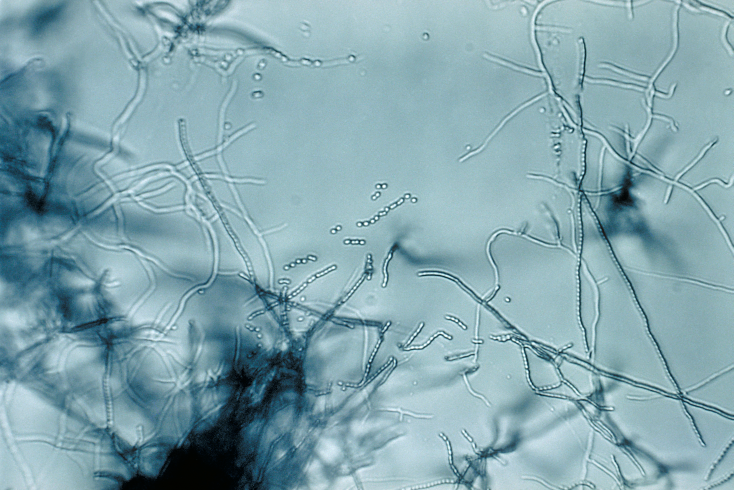Streptomyces
| Streptomyces | ||||||||||
|---|---|---|---|---|---|---|---|---|---|---|
 Slide culture of a Streptomyces sp.
| ||||||||||
| Scientific classification | ||||||||||
| ||||||||||
| Species | ||||||||||
|
S. ambofaciens |
|
WikiDoc Resources for Streptomyces |
|
Articles |
|---|
|
Most recent articles on Streptomyces Most cited articles on Streptomyces |
|
Media |
|
Powerpoint slides on Streptomyces |
|
Evidence Based Medicine |
|
Clinical Trials |
|
Ongoing Trials on Streptomyces at Clinical Trials.gov Clinical Trials on Streptomyces at Google
|
|
Guidelines / Policies / Govt |
|
US National Guidelines Clearinghouse on Streptomyces
|
|
Books |
|
News |
|
Commentary |
|
Definitions |
|
Patient Resources / Community |
|
Patient resources on Streptomyces Discussion groups on Streptomyces Patient Handouts on Streptomyces Directions to Hospitals Treating Streptomyces Risk calculators and risk factors for Streptomyces
|
|
Healthcare Provider Resources |
|
Causes & Risk Factors for Streptomyces |
|
Continuing Medical Education (CME) |
|
International |
|
|
|
Business |
|
Experimental / Informatics |
Overview
Streptomyces, the largest genus of Actinobacteria, is a group of Gram-positive and generally high GC-content bacteria.[1] Streptomycetes are found predominantly in soil and in decaying vegetation, and most produce spores. Streptomycetes are noted for their distinct "earthy" odor which results from production of a volatile metabolite, geosmin.
Streptomycetes are characterised by a complex secondary metabolism.[1] They produce over two thirds of the clinically useful antibiotics of natural origin antibiotics , (Neomycin, Chloramphenicol) to name but a few[2]; the now rarely used streptomycin takes its name directly from Streptomyces. Streptomycetes are infrequent pathogens, though infections in human such as mycetoma can be caused by S. somaliensis and S. sudanensis and in plants such as scabies can be caused by S. caviscabies and S. scabies.
Genomics
The complete genome of one of the strain, "S. coelicolor" A3(2), was published in 2002.[3] At the time, the "S. coelicolor" genome contained the largest number of genes of any bacterium. The genome sequence of S. avermitilis was completed in 2003.[4] This is the first complete genome sequence of the industrial microorganism. Both of these genomes comprise a single chromosome that is linear, unlike most bacterial genomes which comprise a circular chromosome. The genome sequence of S. scabies, a member of the genus with the ability to cause potato scab disease, has been determined at the Wellcome Trust Sanger Institute and is currently in annotation, with publication scheduled for 2007.
Taxonomically, "S. coelicolor" A3(2) belongs to the species of S. violaceoruber and not a validly described separate species; don't mistake S. coelicolor A3(2) for S. coelicolor (Müller) (ATCC 23899).
Biotechnology
In recent years, biotechnology researchers have begun to use Streptomyces spp. for production of recombinant human proteins. Traditionally, Escherichia coli was the species of choice to host eukaryotic genes since it was well understood and easy to work with.[5][6] However, E. coli introduces problems such as incorrect (or lack of) glycosylation and incorrect protein folding, resulting in insolubility and loss of bioactivity of the product.[7] Streptomyces spp. on the other hand have the ability to secrete correctly folded recombinant proteins into the medium after production simplifying the subsequent purification steps. These properties among others make Streptomyces spp. an attractive alternative to other bacteria such as E. coli and Bacillus subtilis.
Medicine
Streptomyces is the largest antibiotic producing genus ([1]), producing both antibacterials and antifungals, and also a wide range of other bioactive compounds such as immunosuppressants
Some of the antifungals produced by Streptomyces spp.
- see also polyene antimycotic
- Nystatin (from S. noursei)
- Amphotericin B (from S. nodosus)
- Natamycin (from S. natalensis)
Some of the antibiotics produced by Streptomyces spp.
- Erythromycin (from S. erythreus)
- Neomycin (from S. fradiae)
- Streptomycin (from S. griseus)
- Tetracycline (from S. rimosus)
- Vancomycin (from S. orientalis)
- Rifamycin (from S. mediterranei)
- Chloramphenicol (from S. venezuelae)
Some of the anti-cancer compounds produced by Streptomyces spp.
- Migrastatin (from S. platensis)
References
- ↑ 1.0 1.1 Madigan M; Martinko J (editors). (2005). Brock Biology of Microorganisms (11th ed. ed.). Prentice Hall. ISBN 0-13-144329-1.
- ↑ Kieser, T., Bibb, M. J., Buttner, M. J., Chater, K. F., and Hopwood, D. A. (2000). Practical Streptomyces Genetics, 2nd edn., Norwich, UK: John Innes Foundation.
- ↑ Bentley SD; et al. (2002). "Complete genome sequence of the model actinomycete "Streptomyces coelicolor" A3(2)". Nature. 417: 141&ndash, 147. PMID 12000953.
- ↑ Ikeda H; Ishikawa J; Hanamoto A; Shinose M; Kikuchi H; Shiba T; Sakaki Y; Hattori M; Omura S (2003). "Complete genome sequence and comparative analysis of the industrial microorganism Streptomyces avermitilis". Nat. Biotechnol. 21: 526&ndash, 531. PMID 12692562.
- ↑ Brawner M, Poste G, Rosenberg M, Westpheling J (1991). "Streptomyces: a host for heterologous gene expression". Curr Opin Biotechnol. 2 (5): 674–81. PMID 1367716.
- ↑ Payne G, DelaCruz N, Coppella S (1990). "Improved production of heterologous protein from Streptomyces lividans". Appl Microbiol Biotechnol. 33 (4): 395–400. PMID 1369282.
- ↑ Binnie C, Cossar J, Stewart D (1997). "Heterologous biopharmaceutical protein expression in Streptomyces". Trends Biotechnol. 15 (8): 315–20. PMID 9263479.
Further reading
- Baumberg S (1991). Genetics and Product Formation in Streptomyces. Kluwer Academic. ISBN 978-0306438851.
- Gunsalus IC (1986). Bacteria: Antibiotic-producing Streptomyces. Academic Press. ISBN 978-0123072092.
- Hopwood DA (2007). Streptomyces in Nature and Medicine: The Antibiotic Makers. Oxford University Press. ISBN 978-0195150667.
See also
- Antimycin A - compound produced by this bacteria used in piscicides.
External links
- Some current Streptomyces Research & Methods / Protocols / Resources
- S. avermitilis genome homepage (Kitasato Institute for Life Sciences)
- S. avermitilis is the avermectin producer.
- S. coelicolor A3(2) genome homepage (Sanger Institute)
- Streptomyces.org.uk homepage (John Innes Centre)
- ScoDB - the S. coelicolor A3(2) genome annotation server
- Streptomyces Genome Projects from Genomes OnLine Database